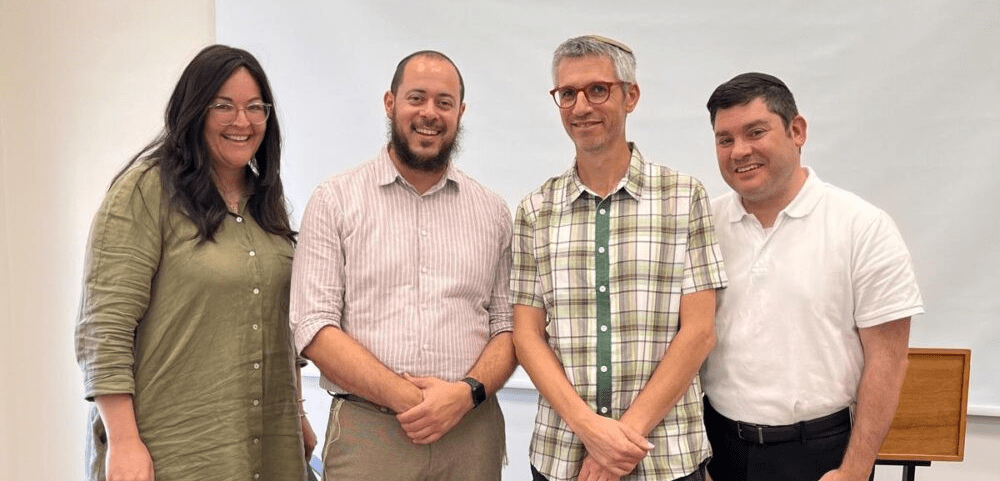
01 Aug Spiritual Literacy
Together with Avigail Wonder, I have recently attended a conference in Israel focussed on deepening spirituality within schools. Spirituality is multifaceted and, in the should not be limited to the realm of bein adam lemakom (deeds that are between us and HaShem). Rather, spirituality is manifest in a variety of meaningful experiences, including encounters with others that go beyond trivialities and involve deep listening and sharing. Indeed, HaShem spoke to Moshe from between the two kruvim (cherubs), simulating the notion that G-dliness is to be encountered in the energy between two individuals who communicate in earnest. To take this notion further, we are taught that if a husband and wife are meritorious, the shechina (Divine presence) dwells between them. Husband and wife are (or should be) the model of the deepest and most intimate connection that two human beings can form – and it is specifically in that context that HaShem’s presence is most palpable.
What does this mean for the classroom?
More than just a facilitator of content, teachers are charged to be facilitators of students. In addition to ‘getting through the curriculum’, the role of a teacher is to form a classroom environment in which the shechina can dwell, a product of meaningful relationships cultivated between all the personalities that make up the class. Lifnai v’Lifnim (or LafLaf), the program spearheaded by veteran educators in Israel’s Mekor Chaim Yeshiva in Neve Daniel, seeks to promote this form of spiritual pedagogy, provide educators with the training that sets them on a journey of becoming a teacher who is focussed more on the inner world of both themselves and their students.
What are examples of this approach?
Developing spirituality in students (and oneself) is multifaced, and a range of approaches were explored. One element the cohort of educators explored is a method known as ‘the bracha rishona’ (opening blessing). When we perform a mitzva or enjoy a part of HaShem’s magnificent creation, we first make a bracha, forming intention and giving purpose to the act we are about to perform. The bracha rishona acts as a small pause in which one asks oneself fundamental questions; What am I about to do? Are my intentions pure? Why am I about to do this?
This pause for self-reflection re-shape the act that follows, imbuing it with spirit and focus. In the classroom setting, a bracha rishona can take a great variety of forms. In essence it is an activity that helps the group transition from what came before (recess, a previous class, tefilla, an argument, an encounter) and what is to come (learning, listening, sharing, growing). A bracha rishona can be as simple as providing each student the opportunity to share how present they feel on a scale of 1-10 (mispar nochechut in LafLaf speak), or having them simply say their name and it being echoed back to them by their peers. It can involve each student sharing something meaningful about themselves, answering question such as “what is something about me that you wouldn’t know just by looking at me?” or “what’s something I need to set aside in order to be more present today?” Further forms of bracha rishona include a thought-inducing question that acts as a link to the learning which is to follow.
The outcome of such an activity is to open the eyes of both the teacher and fellow students to the inner life of members of the class, thus promoting a deeper sense of connectedness between the group and helping students become more present in the moment, and thus more open to the learning that is to follow.
A further activity we explored in the conference was that of parnassut, whereby a member of the cohort is given the opportunity to share something about themselves with the class (such as a meaningful story or basic biographical details) and then present a dilemma that is on their mind. The student is coached in advance to assist them in formulating their presentation, as well as to ensure that what is shared is appropriate for the classroom setting. During the parnassut fellow students learn active listening skills and are encouraged to ask clarifying questions, connect to an emotion expressed by the parnas and are reminded to abstain from giving advice or sharing their own similar experiences. The purpose of this experience is to enable each student to feel heard and appreciated where they are, and to open up the class to the unique world that exists within their fellow.
The bracha rishona and parnassut are two elements of the LafLaf approach, which also speaks in large part to the way in which Torah learning occurs, stirring it in a direction that is personally meaningful. Indeed, the word Torah stems from the Hebrew word hora’ah (a lesson or directive) and thus requires some level of introspection for it to have its intended impact. Given your limited attention span, the LafLaf approach to Torah learning may form the subject of a future Kesher article.
Since March this year, the secondary Jewish Studies staff have been practicing the LafLaf approach in our regular meetings, and we are already feeling its impact in the deeper sense of fraternity felt between us. This semester we are beginning to apply this pedagogical approach to our teaching of Parsha. Not every class is presently experiencing this method yet, as we are choosing to apply it thoughtfully and reflectively, and we look forward to gradually increasing its prevalence as staff gain greater confidence with the new and exciting approach.
We are especially grateful to UnitED, the Pincus Fund and the Misrad Hatfutzot for their generous funding of this new initiative.
Chaim Cowen




